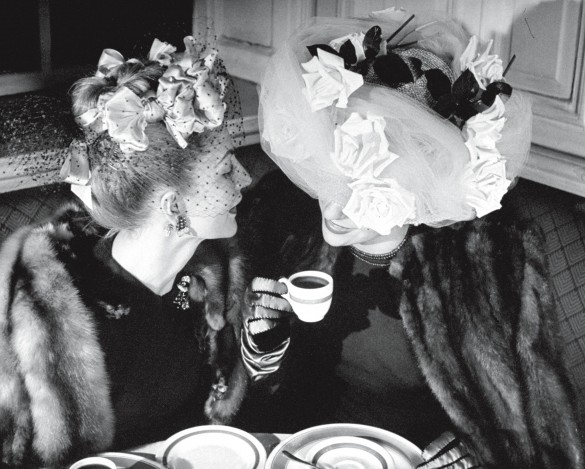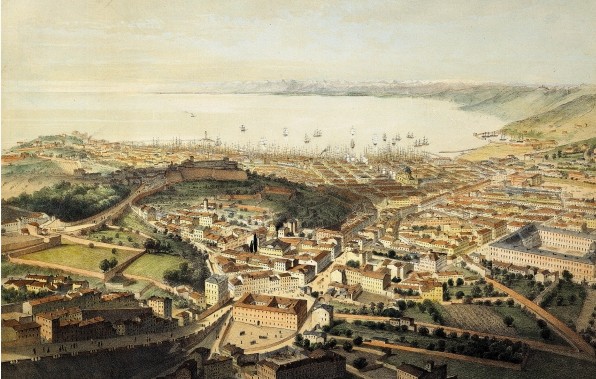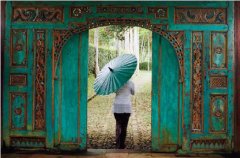The basic knowledge of Coffee Culture Ulysses Coffee
Core hint: corresponding to the hundred Wine fighting Poems in the East, coffee has also been endowed with the legendary status of "magic medicine" in western literature. Today, Espresso and its derivatives are synonymous with "literary coffee", and the birth of Espresso is closely related to the eastern Italian city of Trieste. Although the celebrity list of cafes here is not as dazzling as that of Rome and Paris, it also has its own pride, and one of the leaders is James Joyce. According to Trieste's travel brochure, Joyce completed "Dubliners" and "Portrait of a Young Artist" here, and the original idea of the masterpiece Ulysses began here.

Well-dressed women in a cafe (pictured in the 1940s)
* Trieste *
With regard to Joyce's preference for coffee taste, the first thing to clarify is that although Joyce is from Ireland, it is almost impossible for him to drink the so-called "Irish coffee". Irish coffee is a mixture of hot coffee, Irish Whiskey and sugar, topped with a thick layer of milk foam. There are many ambiguous legends about the origin of this coffee, the most romantic version of which is that a barista at Shannon Airport in Ireland prepared it for a stewardess he had a crush on. A more realistic version is that on a cold winter night, the barista at the airport bar invented this exciting "coffee cocktail" to appease passengers who missed their flight. No matter which version, Irish coffee was born in the late 1940s, and Joyce died in Zurich in 1941, not to mention that he has not returned to Ireland since 1912.
Joyce first came to Trieste in 1904 and has lived in the city for more than ten years since then. Compared with the history of coffee cooking, you can imagine what kind of choice Joyce would face in a cafe. In 1901, the first commercial coffee machine using steam as a source of pressure was born in Italy. With the development of various related technologies, all kinds of pressurized coffee machines were all the rage in Italy in the 1920s, among which the real concern with Trieste is the Illetta invented by Francisco Italian in 1935. The patent registered at that time called it the first coffee machine pressurized by compressed air. It was based on this coffee machine that Francisco Yili established a coffee kingdom named after him "Illy" in Trieste.
Today Trieste belongs to Italy, but that doesn't mean Joyce tasted the budding Espresso when he lived there. After all, this is Trieste.
Trieste also has a more poetic translation, Tristan, but it seems to have been difficult to promote. The city can be called the miniature stage of centuries of strife on the Istrian Peninsula, and as a port city, it has to bear the extra burden of other historical events: on July 2, 1914, on the road from the port of Trieste to the railway station, a procession of coffins was escorted by the Austro-Hungarian Crown Prince and his wife who had just been assassinated in Sarajevo. Although the name Trieste is a mouthful, it has become a forced memory in most Chinese history books.
Joyce sent a letter from Trieste that the city belonged to "Austria". Like many things that have happened in Trieste, coffee has a crossroads here. Despite many ups and downs, the Habsburg dynasty of Austria was one of the longest to govern the area in modern times. The most splendid buildings in the city date from the Austro-Hungarian Empire. Hungarian-style cafes are famous for their gorgeous interiors, and several old cafes in Trieste continue this style. Traditional Turkish coffee is cooked with spices such as cloves, cardamom and cinnamon, and does not filter the dregs. The top of the brewed coffee is covered with foam, which is actually similar to the Crema on the surface of Espresso coffee. Legend has it that the Austrian picked coffee beans from the Turkish army. To suit the European taste, the first cafe opened in Vienna in 1684 modified it by pouring milk into the black coffee and then spawning variants of varying degrees of milk. One of the most gorgeous versions was the later "cream-coffee-syrup" syllogism of Viennese coffee (Viennese). Viennese Coffee naturally came to Trieste with Austria-Hungary.
The Italian writer Claudio Magris, who was born in Trieste in 1939, lamented in the famous Microcosmi: "the empire no longer exists, but the city is still the same, just like SanMarco." But which one does "empire" refer to? In the same book, Margolis emphasizes that the logo of St. Mark's Cafe is the flying lion of Venice, the symbol of the Principality of Venice at that time. In 1720, Venice opened the first coffee shop in Italy. The port city is no stranger to the practice of mocha coffee (Mocha) from Yemen: lots of cream diluted with cinnamon and cocoa powder. As a result, Italy has a long history of affinity for coffee with heavy milk and sugar flavor. To this day, Italian baristas are still good at playing various coffee-to-milk ratios and word games: "Caffemacchiato" is to add a little hot milk to coffee; "LatteMacchiato" is to add a little coffee to milk. Of course, the cafes of Trieste will not ignore this tradition.

Just three days after Joyce's arrival in Paris, there was a long-rumored story about the cafe: Joyce met with Beech, the owner of Shakespeare's bookstore, at the "Twin even" Cafe in Paris and confirmed the publication of Ulysses.
* Ulysses *
As early as the 1930s, there were more than a hundred cafes registered in Trieste. Famous time-honored cafes operating so far are: Tommaseo, Degli Specchi, Tergeste, Stella Polare and San Marco. In her famous travel book about Trieste, Jane Morris (Jan Morris) describes the cafes as "bourgeois" until the 21st century. As for the typical "bourgeois sentiment" of the region at the end of the 19th century, it was described by the Slovenian poet Tomaz Salamun: "they are solid, steady and bearded, and they are lifelong dreamers and bankers." However, this description does not fully apply to the San Marco Cafe. San Marco is not the oldest cafe in Trieste, but it has become a famous sight of "literati worship" because of its unique cultural tradition. During the two world wars, San Marco became a gathering place for people with different political or cultural views. In the "miniature world", San Marco is described as "Noah's ark".
The oldest cafe in Trieste is Tomaseo, which was built during the Habsburg dynasty. It is decorated with classical elegance, is close to the opera house, and has countless musicians such as Mahler and Toscanini on the celebrity list. Even in strapped times, Joyce tried to get all kinds of opera opportunities and boasted an ancestral tenor voice. Joyce's view of these cafes with celebrity footprints may refer to a letter he wrote from Rome in 1906: "I had to go to a Greek restaurant. Amir, Thackeray, Byron, Ibsen and others were all regulars here." The "Greek restaurant" in the letter is the famous Greek cafe in Rome. Keats returned to Italy to recuperate from illness and did not forget to ask Shelley to take him to pay his respects. Thackeray and Byron aside, Ibsen was Joyce's idol for many years and his main motivation for learning Danish.
In the same letter, Joyce immediately complained about the high price of coffee in the Greek cafe and reminded his brother in Trieste to send him a newspaper. Since Trieste, the cafe has been Joyce's main source of free newspapers, and Joyce often spends his time after lunch in the cafe until before dinner. even if the bottom of the trousers has been worn thin and must be covered with a coat in the summer. Joyce reads newspapers, writes letters and responds to advertisements for foreign language tutors in the cafe. He once blamed in his home letter that he missed two well-paid tutors because he didn't get the remittance in time and didn't have the money to go to the cafe to read the newspaper. Joyce is a rare meticulous person who will haggle over every penny and list bills in his home letters. These bills show that he usually spends 0.15 lire on afternoon coffee in Rome, and Trieste's consumption can also be estimated. Compared with the 0.55 lira spent on afternoon coffee by his wife and son, Joyce's coffee is probably the cheapest "basic" in the store.
Joyce's bill describes far more wine than coffee, as well as in his work. One of the rare examples is this paragraph: "the boss put a steaming, almost overflowing high-end mixed drink called coffee on the table."... As the saying goes, it is immoral to find fault. Mr Bloom thought that he might as well stir or try to stir the sugar bumps at the bottom of the cup. Now have a sip.' When he finished stirring up the coffee, he tried to persuade. Persuaded to taste it at least, Stephen grabbed the handle of the heavy mug, lifted it from a large pool of brown liquid, and took a sip of the hard drink. " This is a passage in Ulysses in which Bloom pulls Stephen to sober up. Ulysses is set in Dublin, but many scholars believe that Bloom's image is influenced by Joyce's experience in Trieste. On this level, take Ulysses to Trieste to find the original "Joyce Coffee", you might as well take this as a reference.
Talking about the meaning of "Ulysses" is still a major event even among professional scholars. Fortunately, most scholars have accepted that there is a certain sense of positive or negative drift implied in the book. "Trieste swallowed up my liver," Joyce said in his later years. " No one dares to speculate whether the master who plays with words is talking about the place name "Trieste" or whether he borrows the meaning of "sadness" implied by the word "Trieste".

"Trieste" is the Chinese translation name of Trieste, and it also has a more poetic translation name "Tristan", but it seems to be difficult to promote. Perhaps the twists and turns in the city's history can only be understood by a complicated and polysyllabic Chinese name.

As early as the 1830s, more than a hundred cafes were registered in Trieste. Jane Morris lamented that these cafes "retained a bourgeois feel" into the 21st century.
There are countless other celebrities who have signed up in Trieste. Morris's travelogue notes that "Casanova lived in Trieste between 1772 and 1774, and according to the written records he left, he should have been happy, but as soon as the ban on Venice was lifted, he left quickly within a week." The Austrian painter Egon Schiele came here to relax after a short imprisonment, but hastened back to Vienna before he could produce a few watercolors of the harbour." Morris concluded with a pithy conclusion: "Trieste is such a desirable place-secret and ambiguous, and it has indeed become a second home for many willing and involuntary exiles, many of whom have spent most of their lives here, but whose hearts are always longing for somewhere else. This is a great irony for trieste. It's both attractive and sad."
"Silence, exile, cunning"(silence, exile, cunning), Joyce later summed up an exile's way of life in his play "The Exile" in the main character's tone. Joyce of Trieste does indeed seem like an exile when he first arrives, eloping with his girlfriend Nora to begin what he calls an "experiment" for a living. The ill-tempered Joyce scolded Trieste in a letter home when she first arrived: "Trieste is the most barbaric place I have ever lived." But that didn't stop him from later documenting how the landlady did everything she could to help Nora when she gave birth unexpectedly. In the same letter home Joyce complained that there were no "intelligent upper classes to dine with" and one of the first acquaintances after Ulysses was published was a Greek merchant from Trieste. Hector Schmitz, known under the pen name Italo Svevo, was a painter in Trieste who became Joyce's best friend, and it was Joyce's strong recommendation that his famous work Zeno's Consciousness gained critical recognition. Joyce, who had derided the Trieste people as "full of mistakes" in his early years as a language teacher, deliberately used the local Italian-German "patois" in his correspondence with Svevo's widow in his later years. A postcard dated June 16, 1915, from Joyce's Trieste, proved to be significant. "June 16" became the date Ulysses was set for. The postcard read: "The first fragment of my new long Ulysses has been completed. The first part, Telemachus, consists of four chapters; the second part, fifteen chapters, Ulysses 'Wanderings; and the third part, Ulysses' Return, consists of three more chapters."
*Espresso*
Joyce returned to Trieste from Zurich in October 1919. Soon after, he left Trieste in July of the following year and never returned. Joyce went to Paris, and within three days of his arrival there was a long-rumored café legend: Joyce met with Beech, the owner of Shakespeare's bookshop, at Les Deux Magots in Paris to finalize the publication of Ulysses. Joyce's only direct account of coffee in Parisian cafes is a letter from his early medical studies in Paris: "I laugh at the mere mention of Balzac, Swinburne, and the like. More than once I have knocked over an entire cup of French coffee with laughter." Yet a dozen years later Joyce's biographers describe his state of mind during his stay in Paris as: "He kept silent about literary matters, protecting himself with a fearful silence."
Ulysses was published on February 2, 1922, Joyce's 40th birthday. At the end of his life Joyce lived in Zurich. Zurich's most famous café is Odeon, where Joyce visited several times during his stay in Zurich from 1915 to 1919. Auden was the cradle of Dadaism, and the coffeehouses of Trieste were celebrating the end of Futurism. When Joyce returned to Zurich in his later years, his frequent café was replaced by Pfauen, near the theatre. It was already 1940, and in Trieste, not far away, the Espresso kingdom of the Italian family had initially established itself in the surrounding area, thus promoting this emerging coffee culture to Northern Europe. Whether Joyce drank this "new product" from Trieste in his later years is unknown, except that Joyce's correspondence with Trieste in his later years is so frequent that he often recalls it as another hometown.
Many biographies of Francesco Italia's connection to Trieste state: "Francesco of Hungarian descent came to Trieste with the Austro-Hungarian army during World War I. At the end of the war, Trieste was ceded to Italy. Francesco stayed." "War,""army,""belong," these are typical words that occur frequently in Trieste, but "stay" is something different. Morris, who lamented that Trieste was only a transit point for exiles, also noted that, unlike the exiles who soon grew bored,"thousands of unknown foreigners, including Greeks, Armenians, and Turks, came to Trieste and lived there." Francesco illy's experience is closer to this one. Francesco's son Ernesto set up a research laboratory after graduating from the local university, and his passion for coffee earned him the title of "coffee missionary". Riccardo, the third generation of the Italian family, later served as mayor of Trieste. Morrison once described Riccardo Illy in his travels as a traditional representative of Trieste culture: "involved in economic, artistic, social and political fields at the same time,""elegant and decent behavior... but never wearing a tie."
Scipio Slataper, a poet native to Trieste, wrote: "Wake up in the morning among boxes of lemons and bags of coffee beans." At least to an observer, coffee bean trafficking may seem a bit poetic, and Rambo, who wrote Drunken Boat, did it anyway. Authentic Espresso rarely uses coffee beans from a single region, but is often a mixture of coffee beans selected from several or more different regions across the ocean. Its specific origin and proportion are one of the closely guarded trade secrets of each family. This feeling is quite similar to Joyce's description of his own work. In a letter to his publisher in 1921, Joyce described the Ulysses material in his head as "cobblestones, garbage, broken matches, and broken glass from all over." The so-called instant beauty, let Espresso stay, let Ulysses set sail at the same time, perhaps only a city like Trieste can do it. Greek legend records that the Golden Fleece heroes entered an underground undercurrent on their way home, and when they returned to the sun, the haven before them was Trieste. As the predecessor of Jason and others, if Ulysses were still wandering today, he would probably be tempted to return to Trieste for a drink, and it should be Espresso.
Important Notice :
前街咖啡 FrontStreet Coffee has moved to new addredd:
FrontStreet Coffee Address: 315,Donghua East Road,GuangZhou
Tel:020 38364473
- Prev

The ancient cultural story of Antigua coffee in Guatemala
Fragrant history a cup of Guatemalan Antigua coffee seems to let us see the sudden disappearance of the mysterious Mayans multiply in the ancient land, history brushed away their existence, history has achieved their eternity. If a person's wrinkles depict a person's path, then the smell of coffee remembers the origin of a cup of coffee: about its hometown and harvest year.
- Next

Basic knowledge of Fine Coffee Culture
I don't know how you are in other parts of Southeast Asia, but I am always at a loss on the streets of Singapore, on the corner of Vietnam and on a sign in Malaysia. Although transliteration of things like coffee was widely used by clever ancestors in the early years of its spread, there is not much audio-visual barrier, even though Singaporeans always refer to coffee as Kopi, which is pronounced from Hokkienese.
Related
- How did the Salvadoran coffee industry develop in Central America?
- What exactly does the golden cup extraction of coffee mean?
- The Origin of Coffee flower
- [2023 Starbucks World Earth Day] there are more meaningful things besides free Starbucks coffee!
- What kind of coffee is there in Spain? 9 Flavors of Spanish Coffee
- Aromatic African coffee| Kenya's coffee culture and historical production area
- Liberica Coffee Bean knowledge: the characteristics of Liberian Coffee beans of the three original species of Coffee beans
- The origin and formula of Spanish latte introduces the taste characteristics of Bombon coffee in Valencia, Spain.
- How to adjust the solution of over-extracted coffee
- What is the tasting period of coffee beans? What is the period of coffee and beans? How should coffee wake up and raise beans?

